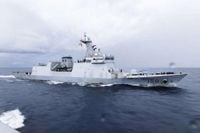In the churning waters of the South China Sea, a region long marked by competing territorial claims and simmering tensions, Australia, Canada, and the Philippines have just wrapped up a high-profile joint naval exercise east of the disputed Scarborough Shoal. This operation, known as Exercise ALON 2025, marks not only the largest military collaboration between the Philippines and Australia to date, but also signals a growing trend of multinational defense cooperation in one of Asia’s most sensitive maritime flashpoints.
The drill, which concluded on August 27, 2025, brought together three major surface combatants: the Philippine Navy’s guided-missile frigate BRP Jose Rizal, the Royal Australian Navy’s destroyer HMAS Brisbane, and the Royal Canadian Navy’s frigate HMCS Ville de Québec. These warships, accompanied by fighter jets and combat helicopters, conducted a series of complex maneuvers and air defense exercises designed to simulate responses to aerial threats. According to the Armed Forces of the Philippines, the exercise aimed to "hone the participants’ capability to counter simulated aerial threats through coordinated defensive maneuvers." Video footage released by the Philippine military showed at least three fighter jets soaring overhead and two combat helicopters patrolling near the naval vessels.
But the significance of Exercise ALON 2025 extends well beyond the tactical. The drills were staged in one of the world’s most hotly contested maritime areas, just east of Scarborough Shoal—a fishing atoll that has become a symbol of the ongoing rivalry between China and its Southeast Asian neighbors. China, which claims almost the entire South China Sea under its controversial nine-dash line, has maintained a heavy presence around Scarborough Shoal and other disputed territories, often using what Philippine officials have described as "risky maneuvers" to drive away foreign vessels. The Permanent Court of Arbitration in The Hague ruled in 2016 that China’s sweeping claims were without legal basis, but Beijing has refused to recognize the verdict and continues to guard the area with its navy, coast guard, and maritime militia.
Philippine Colonel Dennis F. Hernandez, executive agent for Exercise ALON, was careful to emphasize that the operation was "not aimed at any country," insisting instead that its true purpose was to uphold a "rules-based international order" in the region. Still, the message to Beijing was unmistakable. The drills, which included air defense maneuvers, formation steaming, live-fire exercises, amphibious landings, and even special forces training with Javelin anti-tank missiles and sniper systems, showcased the increasing sophistication and interoperability of allied forces. Australia contributed F/A-18 fighter aircraft and C-130 Hercules transport planes, while Canada and other security partners sent military observers, highlighting the broadening coalition of nations invested in regional stability.
Exercise ALON 2025 was no small affair. Running from August 15 to 29, it involved more than 3,600 military personnel and spanned a dizzying array of activities—from beach assaults and airlift operations to anti-submarine warfare training and night formation steaming. The inclusion of advanced assets such as the Aegis-equipped HMAS Brisbane and the modernized Jose Rizal-class frigate brought the drill up to standards comparable with NATO exercises, underscoring the leap in capabilities and joint readiness.
For Manila, these drills are about more than just military preparedness. As reported by BusinessWorld, the Philippines sees such engagements as a way to "advance defense cooperation with like-minded nations," boosting both deterrence and diplomatic leverage in its ongoing disputes with China. The Philippine military has increasingly leaned on multinational cooperation, conducting more frequent joint patrols and naval exercises with the United States and other regional partners. What was once rare—multinational military cooperation in these contested waters—is fast becoming routine. Earlier this year, the Philippines took part in trilateral air and sea patrols with the US and Australia.
China, for its part, has repeatedly warned that it will defend Scarborough Shoal and its outlying waters "at all cost," and has kept a close watch on the area. Just weeks before the recent drills, a Chinese navy ship accidentally collided with a Chinese coast guard vessel while trying to block a Philippine ship near the shoal, resulting in severe damage and, according to Philippine officials, possibly at least two Chinese casualties. China has not provided details on the incident, fueling speculation and further highlighting the volatility of the region.
The United States, which has no direct territorial claims in the South China Sea but is a treaty ally of the Philippines, has also made its presence felt. On August 13, two US Navy warships conducted freedom of navigation operations about 30 nautical miles from Scarborough Shoal, shadowed by a Chinese navy ship but without reported incident. Washington has repeatedly reminded Beijing that it is obligated to defend the Philippines if Filipino forces come under armed attack, a stance that adds yet another layer of complexity to the already tangled web of regional alliances and rivalries.
For Australia and Canada, participation in Exercise ALON 2025 is part of a broader Indo-Pacific defense strategy. Australia, in particular, has been ramping up its naval presence in the region, bolstered by increased defense spending and commitments arising from the AUKUS security pact with the US and the UK. Both nations view their involvement as a demonstration of their commitment to a "free and open Indo-Pacific," a phrase that has become something of a mantra among Western and regional powers seeking to counterbalance China’s assertiveness.
Importantly, Exercise ALON 2025 was conducted within the regular defense budgets of the participating navies, focusing on international training and cooperation rather than specific procurement deals. For the Philippine Navy, it is a key component of a broader modernization agenda, which includes acquiring new surface combatants and upgrading existing fleets to meet the challenges of a rapidly evolving security environment.
As the exercises drew to a close, the message from Manila was clear. "This engagement reaffirms the Armed Forces of the Philippines’ commitment to advancing defense cooperation with like-minded nations," the military said in a statement. The drills, it added, were meant to "uphold regional stability" and maintain the "rules-based international order" in the disputed waters of the South China Sea.
While the immediate impact of these exercises may be hard to quantify, there is little doubt that they mark a significant shift in the security dynamics of the region. By expanding its network of defense partnerships beyond traditional allies like the United States, the Philippines is signaling both a newfound strategic flexibility and a determination to stand firm in the face of mounting pressure. With multinational cooperation now the new normal in these contested waters, the stakes—and the risks—have never been higher.





